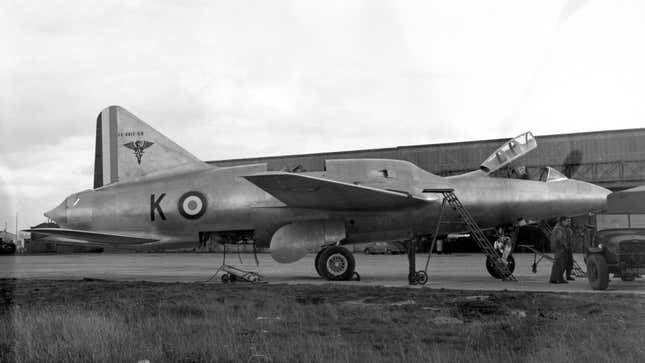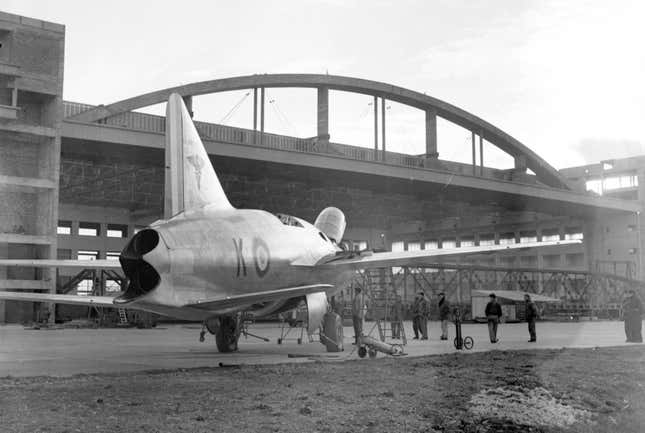
The Sud-Est Grognard looked more like a drawing of a spaceship than a fighter jet. The experimental French jet fighter, of which only two were built, belongs to my favorite era of aircraft: early Cold War experiments. While jet engines saw their combat debut in the flak-ridden skies of the waning days of World War II, figuring out how best to bend an aircraft around an air intake and turbine remains a hard problem.
While ultramodern jets, like the just-unveiled B-21 Raider stealth bomber, solve that with careful shaping of intakes ports, the Grognard’s solution was almost comically straightforward: stick a big opening on the top of the plane, behind and above the cockpit, and trust that the air will feed the engines sufficiently.
At alternative aviation magazine Hush Kit, writers Hugo Mark Michel and Joe Coles compiled a list of “10 Obscure Canceled French Warplanes of the 1950s.” Here’s how they describe the Grognard, ranked 9:
“The primordial soup of the early jet age spawned some extremely ugly aeroplanes – and the SE.2410 Grognard, known derisively as the ‘Bossu’ (hunchback) was one of them. Of many unusual features, its double-decked jet engine arrangement is the most notable, and was later adopted by the English Electric Lightning (and nothing else).”

The plane, they continue, was designed for ground attack, or quickly hitting and bombing tanks, artillery, soldiers, or anything else that might be a threat below. With two engines stacked on top, there was room to hold four 550-pound bombs, or two 750-pound bombs, as well as a rack of rockets, which could fire in an explosive salvo, killing with volume more than accuracy.
At least, that was the premise. The Grognard first flew in 1950, and by 1952 the only two in existence were out of service, plagued by a couple of crashes and a change in role. That still meant enough time for a glowing write-up in the April 1953 issue of Popular Science. Under the headline “New French Jet Fighter Looks Like A Flying Turtle,” the story features a picture of a Grognard landing with parachute assistance, and notes the jet had a range of 645 miles.
By the time that story ran, the plane was canceled. France and other countries developed a range of other jets, and real jet-on-jet warfare took place in the skies above Korea. Depending on how one counts, there have been four or possibly five generations of jet design since.

The Grognard fits into a nice space I have for “real planes that look like they were based on children’s drawings.” While aviation was hardly a new science in 1950, jet aviation meant pairing a much more powerful engine with existing designs, largely worked out for the limits and traits of propeller-driven craft.
It’s an era full of weirdness, and quickly iterated further weirdness. When American defense giant Northrop Grumman unveiled the new B-21 Raider Stealth Bomber at the end of 2022, it had been 34 years since a pre-merger Northrop unveiled the first B-2 Spirit stealth bomber. While the Raider was not continuously in development in the same way, modern aircraft last longer, are more extensively maintained, and only really come together when a government can fund their development at scale for at least a decade.
With the reveal of the Raider, everything was carefully calibrated to conceal as much as possible while announcing a new jet, from the types of phones allowed into the event space to the time of day the plane was announced. The science of modern aircraft design, eight decades into the Jet Age, is refined, full of both trade and national secrets.
The sensors that spot planes, and then guide missiles to shoot them out of the sky, have advanced by leaps and bounds as well. The bare-metal look of Cold War stalwarts, cheap and effective for planes that might see up to a decade of service, has long since been surpassed by protective coatings and color patterns aimed at confusing visual and sensor identification.
While the Grognard’s role in active service ended in 1952, it still flew as a test and training craft for a couple more years. The plane, this little early Cold-War oddity, bears the distinction of being the first French aircraft to fire a French-made air-to-air missile.
